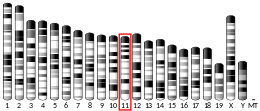NLGN2
نورولایگین-۲ (به انگلیسی: Neuroligin-2) یک پروتئین است که در انسان توسط ژن «NLGN2» کُدگذاری میشود.[۴][۵][۶]
این پروتئین در شکلگیری و بازسازی سیناپسهای دستگاه عصبی مرکزی نقش دارد.[۶]
منابع
[ویرایش]- ↑ ۱٫۰ ۱٫۱ ۱٫۲ GRCm38: Ensembl release 89: ENSMUSG00000051790 - Ensembl, May 2017
- ↑ "Human PubMed Reference:". National Center for Biotechnology Information, U.S. National Library of Medicine.
- ↑ "Mouse PubMed Reference:". National Center for Biotechnology Information, U.S. National Library of Medicine.
- ↑ Philibert RA, Winfield SL, Sandhu HK, Martin BM, Ginns EI (May 2000). "The structure and expression of the human neuroligin-3 gene". Gene. 246 (1–2): 303–10. doi:10.1016/S0378-1119(00)00049-4. PMID 10767552.
- ↑ Nagase T, Kikuno R, Ishikawa K, Hirosawa M, Ohara O (Sep 2000). "Prediction of the coding sequences of unidentified human genes. XVII. The complete sequences of 100 new cDNA clones from brain which code for large proteins in vitro". DNA Res. 7 (2): 143–50. doi:10.1093/dnares/7.2.143. PMID 10819331.
- ↑ ۶٫۰ ۶٫۱ "Entrez Gene: NLGN2 neuroligin 2".
- مشارکتکنندگان ویکیپدیا. «NLGN2». در دانشنامهٔ ویکیپدیای انگلیسی، بازبینیشده در ۲۰ مه ۲۰۱۸.
بیشتر بخوانید
[ویرایش]- Cantallops I, Cline HT (2000). "Synapse formation: if it looks like a duck and quacks like a duck ...". Curr. Biol. 10 (17): R620–3. doi:10.1016/S0960-9822(00)00663-1. PMID 10996085.
- Ichtchenko K, Nguyen T, Südhof TC (1996). "Structures, alternative splicing, and neurexin binding of multiple neuroligins". J. Biol. Chem. 271 (5): 2676–82. doi:10.1074/jbc.271.5.2676. PMID 8576240.
- Irie M, Hata Y, Takeuchi M, et al. (1997). "Binding of neuroligins to PSD-95". Science. 277 (5331): 1511–5. doi:10.1126/science.277.5331.1511. PMID 9278515.
- Kurschner C, Mermelstein PG, Holden WT, Surmeier DJ (1998). "CIPP, a novel multivalent PDZ domain protein, selectively interacts with Kir4.0 family members, NMDA receptor subunits, neurexins, and neuroligins". Mol. Cell. Neurosci. 11 (3): 161–72. doi:10.1006/mcne.1998.0679. PMID 9647694.
- Nagase T, Kikuno R, Ishikawa KI, et al. (2000). "Prediction of the coding sequences of unidentified human genes. XVI. The complete sequences of 150 new cDNA clones from brain which code for large proteins in vitro". DNA Res. 7 (1): 65–73. doi:10.1093/dnares/7.1.65. PMID 10718198.
- Scheiffele P, Fan J, Choih J, et al. (2000). "Neuroligin expressed in nonneuronal cells triggers presynaptic development in contacting axons". Cell. 101 (6): 657–69. doi:10.1016/S0092-8674(00)80877-6. PMID 10892652.
- Strausberg RL, Feingold EA, Grouse LH, et al. (2003). "Generation and initial analysis of more than 15,000 full-length human and mouse cDNA sequences". Proc. Natl. Acad. Sci. U.S.A. 99 (26): 16899–903. doi:10.1073/pnas.242603899. PMC 139241. PMID 12477932.
- Jamain S, Quach H, Betancur C, et al. (2003). "Mutations of the X-linked genes encoding neuroligins NLGN3 and NLGN4 are associated with autism". Nat. Genet. 34 (1): 27–9. doi:10.1038/ng1136. PMC 1925054. PMID 12669065.

